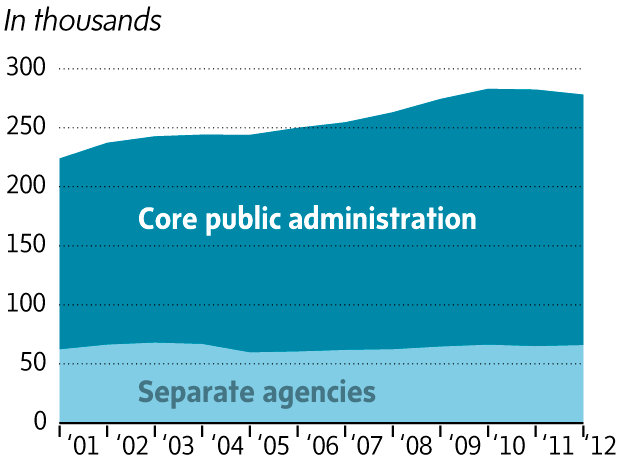Jean Denis-Fréchette, the new Parliamentary Budget Officer, is shown in his office on Sept. 20, 2013.Dave Chan/The Globe and Mail
The federal government's labour costs have increased by $7.8-billion from 2001-02 to 2011-12, but a closer look by the Parliamentary Budget Office concludes individual public servants are not any better off as a result.
Pay levels for federal public servants have largely stayed the same over the past decade, according to a new report released Wednesday.
The PBO looked at $19.43-billion in federal spending on labour in 2011-12, up from $11.58-billion in 2001-02. The federal government spends more than $40-billion in total on labour, but the PBO excluded figures for the military and RCMP, and did not include benefits in its calculations.
The PBO found that new hires account for almost half of the $7.8-billion increase, and the other half is from wage gains. However, when those wage gains are examined more closely, 96 per cent are attributable to inflation. The rest of the increase is real wage growth.
"Cumulatively, changes in classification and real wage growth contributed little to overall labour cost growth," the report concludes. "Recent reductions in the level of employment and the Expenditure Restraint Act of 2009 have been successful in limiting the growth in labour costs. However, to maintain a constant standard of living in the public sector, some labour cost growth is inevitable."
The Conservative government has put unions on notice that it wants further changes to the total compensation packages of public servants. Many union contracts are set to expire over the coming year, and Treasury Board President Tony Clement said he wants new rules in areas like sick leave. The government is also implementing plans that will require employees to contribute more to their own pensions, with a goal of reaching an even split between employee and employer contributions.
According to the Treasury Board, the federal public service grew from 211,925 people in 2000 to a high of 282,955 in 2010. Since then, it has decreased to 262,817.
Federal public service workers
The size of the federal public workforce has risen from 211,925 in 2000 to a high of 282,955 in 2010, according to the Treasury Board of Canada. Since then, the size has decreased slightly to 262,817.

Estimated labour cost changes
Meanwhile, labour costs have increased by a total of $7.8-billion. Below, that figure is broken down into distinct causes by the Parliamentary Budget Office. The bulk of this increase was due to employment growth — the larger the workforce, the higher the overall labour cost. The right side of the pie shows increases to actual wages — the bulk of which is due to inflation, with only four per cent coming from real wage growth.
The figures do not include spending on the military or the RCMP.

 Bill Curry
Bill Curry